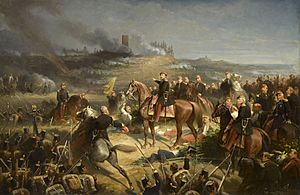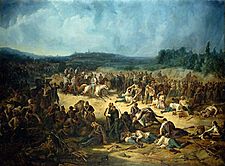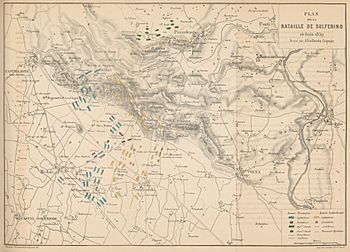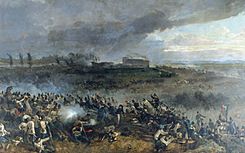Battle of Solferino facts for kids
Quick facts for kids Battle of Solferino |
|||||||
|---|---|---|---|---|---|---|---|
| Part of the Second Italian War of Independence | |||||||
 The Battle of Solferino, by Adolphe Yvon |
|||||||
|
|||||||
| Belligerents | |||||||
| Commanders and leaders | |||||||
| Strength | |||||||
9,162 cavalry 240 guns 1,562 cavalry 80 guns Total: 130,833 320 guns |
119,783 infantry 9,490 cavalry 429 guns Total: 129,273 429 guns |
||||||
| Casualties and losses | |||||||
| France: 1,622 killed Including 117 officers 8,530 wounded 1,518 missing Sardinia: 691 killed Including 49 officers 3,572 wounded 1,258 missing Total: 17,191 |
2,386 killed Including 94 officers 10,634 wounded 9,290 missing Total: 22,310 |
||||||
The Battle of Solferino was a huge fight that happened on June 24, 1859. It was a key part of the Second Italian War of Independence. In this battle, the armies of France and Sardinia teamed up. They were led by Emperor Napoleon III and King Victor Emmanuel II, respectively. They fought against the Austrian Army, led by Emperor Franz Joseph I.
This battle was special because it was the last big battle where kings and emperors personally led their armies. Around 300,000 soldiers fought, making it one of the largest battles in Europe at that time. The French and Sardinian forces won this important battle.
After seeing the terrible suffering of wounded soldiers, a Swiss man named Jean-Henri Dunant was inspired. He wrote a book called A Memory of Solferino. What he saw led to the creation of the Geneva Conventions and the International Red Cross. These groups help protect people during wars.
Contents
What Led to the Battle?
In 1859, Italy was not one country. It was divided into many smaller states, and some parts were controlled by other countries like Austria and France. Many Italians wanted to unite their country. This idea was called the Risorgimento, which means "resurgence" or "rebirth."
France and the Kingdom of Sardinia (a powerful Italian state) decided to work together. Their goal was to push Austria out of Italy. The Battle of Solferino was a major step in this fight for Italian unity.
On June 22, 1859, the French and Sardinian armies were moving towards the Mincio River. The Austrian army, led by Emperor Franz Joseph, also started moving. Both sides were heading towards the same area, which led to an unexpected clash.
The Battle Begins
The Battle of Solferino took place near the villages of Solferino and San Martino in Italy. These villages are located between Milan and Verona, south of Lake Garda.
The fighting started early in the morning of June 24. The French and Sardinian armies were marching east when they suddenly ran into the Austrian troops. Neither side expected to fight exactly where they did.
The battle was very spread out and not well-coordinated. This led to many casualties. The fighting happened in three main areas: Medole in the south, Solferino in the center, and San Martino in the north.
Who Fought in the Battle?
The Austrian army was led by Emperor Franz Joseph himself. It was made up of two main armies, each with several smaller groups called corps.
The French army was led by Emperor Napoleon III. Many of his soldiers and generals had fought in other wars, like the Crimean War. The Sardinian army had four divisions fighting alongside the French.
Even though the emperors and kings were in charge, they had experienced military leaders helping them. This was important because leading such large armies was a huge task.
Fighting at Medole
The battle started around 4 AM in Medole. French troops, part of the 4th Corps, met an Austrian army group. The French general, Niel, decided to attack right away.
This early fight was very important. It stopped a large part of the Austrian army from going to help their comrades near Solferino. The French 4th Corps, even though they had fewer soldiers, managed to hold their ground against repeated Austrian attacks.
Fighting at Solferino
Around 4:30 AM, French troops in the center of the battlefield met Austrian forces near Castiglione delle Stiviere. Other French groups soon joined the fight.
The Austrians held strong positions in the towns of Solferino, Cavriana, and Volta Mantovana. The French attacked these positions many times throughout the day.
Later in the afternoon, French reserve troops joined the fight. They attacked Cavriana, which was a key Austrian position. By 6 PM, the French took Cavriana, breaking through the Austrian lines. This forced the entire Austrian army to retreat.
Fighting at San Martino
On the northern side of the battlefield, the Sardinian army fought the Austrians. This battle started around 7 AM. It was a long and tough fight for control of Pozzolengo, San Martino, and Madonna della Scoperta.
The Austrian commander, Benedek, had about 39,000 men and 80 guns. The Sardinians had 22,000 men and 48 guns. The Austrians fought off three Sardinian attacks, causing many losses.
Even when ordered to retreat, Benedek kept fighting. Finally, at 8 PM, a fourth Sardinian attack captured the hills. Benedek then withdrew. The Sardinians played a crucial role by keeping a large Austrian force busy all day. This stopped the Austrians from sending help to Solferino.
Battle Outcomes
The Battle of Solferino was incredibly difficult and lasted over nine hours. Both sides suffered huge losses. The Austrians had over 2,300 killed, 10,800 wounded, and 8,600 missing or captured. The French and Sardinian armies had about 2,500 killed, 12,500 wounded, and 2,900 missing or captured.
It was a very bloody battle. In the end, the Austrian forces had to give up their positions. The French and Sardinian armies won, but it was a very costly victory. The Austrians retreated to their strong fortresses, and the war soon came to an end.
What Happened After?

Napoleon III was shocked by how many soldiers died. He decided to end the war quickly. An agreement called the Armistice of Villafranca was signed on July 11, 1859.
As a result, Sardinia gained control of Lombardy, a region in Italy. However, they did not get Venetia, another Italian region. In 1861, the Kingdom of Italy was officially formed, bringing much of Italy together.
The battle had a lasting impact on how wars are fought. Jean-Henri Dunant saw the terrible aftermath of the battle. He was horrified by the wounded soldiers left to suffer. This experience made him start a movement that led to the Geneva Conventions. These are rules that protect people during armed conflicts. It also led to the creation of the International Red Cross, an organization that provides humanitarian aid worldwide.
In 2009, the 150th anniversary of the battle was celebrated. Leaders from the European Union noted how important this battle was for creating international laws to protect people in wartime. In 2019, a memorial event took place at the battlefield, with hundreds of volunteers re-enacting the battle to promote peace.
The Battlefield Today
Today, the area where the Battle of Solferino took place has many memorials. These monuments remember the events and the people who fought there.
There is a tall, round tower called the Tower of San Martino della Battaglia. It is 70 meters high and was built in 1893 to honor King Victor Emmanuel II. In the town, you can visit a museum with old uniforms and weapons. There is also an ossuary chapel, which holds the bones of many soldiers.
In Solferino, there is another museum with weapons and items from the battle. It also has an ossuary with the bones of thousands of victims.
Near the battlefield is Castiglione delle Stiviere. Many wounded soldiers were taken there after the battle. This town is now home to the museum of the International Red Cross. It tells the story of how this important organization was formed because of the suffering seen at Solferino.
Images for kids
See also
 In Spanish: Batalla de Solferino para niños
In Spanish: Batalla de Solferino para niños






